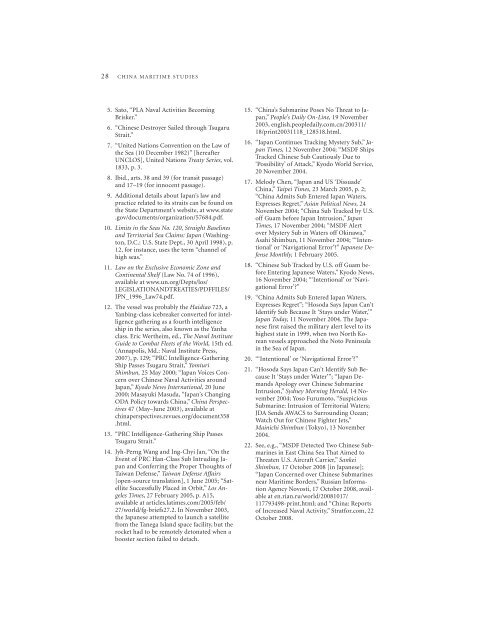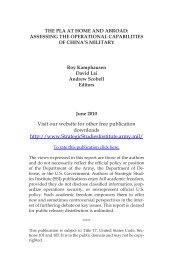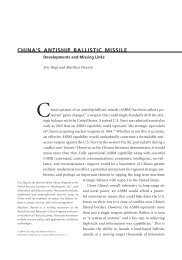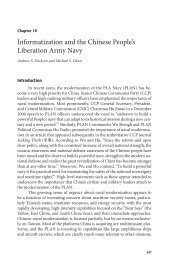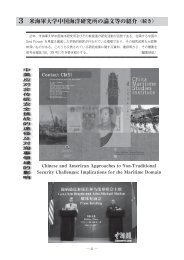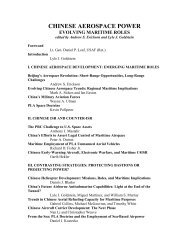Scouting, Signaling, and Gatekeeping - US Naval War College
Scouting, Signaling, and Gatekeeping - US Naval War College
Scouting, Signaling, and Gatekeeping - US Naval War College
You also want an ePaper? Increase the reach of your titles
YUMPU automatically turns print PDFs into web optimized ePapers that Google loves.
28 CHINA MARITIME STUDIES<br />
5. Sato, “PLA <strong>Naval</strong> Activities Becoming<br />
Brisker.”<br />
6. “Chinese Destroyer Sailed through Tsugaru<br />
Strait.”<br />
7. “United Nations Convention on the Law of<br />
the Sea (10 December 1982)” [hereafter<br />
UNCLOS], United Nations Treaty Series, vol.<br />
1833, p. 3.<br />
8. Ibid., arts. 38 <strong>and</strong> 39 (for transit passage)<br />
<strong>and</strong> 17–19 (for innocent passage).<br />
9. Additional details about Japan’s law <strong>and</strong><br />
practicerelatedtoitsstraitscanbefoundon<br />
the State Department’s website, at www.state<br />
.gov/documents/organization/57684.pdf.<br />
10. Limits in the Seas No. 120, Straight Baselines<br />
<strong>and</strong> Territorial Sea Claims: Japan (Washington,<br />
D.C.: U.S. State Dept., 30 April 1998), p.<br />
12, for instance, uses the term “channel of<br />
high seas.”<br />
11. Law on the Exclusive Economic Zone <strong>and</strong><br />
Continental Shelf (Law No. 74 of 1996),<br />
available at www.un.org/Depts/los/<br />
LEGISLATIONANDTREATIES/PDFFILES/<br />
JPN_1996_Law74.pdf.<br />
12. The vessel was probably the Haidiao 723, a<br />
Yanbing-class icebreaker converted for intelligence<br />
gathering as a fourth intelligence<br />
ship in the series, also known as the Yanha<br />
class. Eric Wertheim, ed., The <strong>Naval</strong> Institute<br />
Guide to Combat Fleets of the World, 15th ed.<br />
(Annapolis, Md.: <strong>Naval</strong> Institute Press,<br />
2007), p. 129; “PRC Intelligence-Gathering<br />
Ship Passes Tsugaru Strait,” Yomiuri<br />
Shimbun, 25 May 2000; “Japan Voices Concern<br />
over Chinese <strong>Naval</strong> Activities around<br />
Japan,” Kyodo News International, 20 June<br />
2000; Masayuki Masuda, “Japan’s Changing<br />
ODA Policy towards China,” China Perspectives<br />
47 (May–June 2003), available at<br />
chinaperspectives.revues.org/document358<br />
.html.<br />
13. “PRC Intelligence-Gathering Ship Passes<br />
Tsugaru Strait.”<br />
14. Jyh-PerngWang<strong>and</strong>Ing-ChyiJan,“Onthe<br />
Event of PRC Han-Class Sub Intruding Japan<br />
<strong>and</strong> Conferring the Proper Thoughts of<br />
Taiwan Defense,” Taiwan Defense Affairs<br />
[open-source translation], 1 June 2005; “Satellite<br />
Successfully Placed in Orbit,” Los Angeles<br />
Times, 27 February 2005, p. A15,<br />
available at articles.latimes.com/2005/feb/<br />
27/world/fg-briefs27.2. In November 2003,<br />
the Japanese attempted to launch a satellite<br />
from the Tanega Isl<strong>and</strong> space facility, but the<br />
rocket had to be remotely detonated when a<br />
booster section failed to detach.<br />
15. “China’s Submarine Poses No Threat to Japan,”<br />
People’s Daily On-Line, 19 November<br />
2003, english.peopledaily.com.cn/200311/<br />
18/print20031118_128518.html.<br />
16. “Japan Continues Tracking Mystery Sub,” Japan<br />
Times, 12 November 2004; “MSDF Ships<br />
Tracked Chinese Sub Cautiously Due to<br />
‘Possibility’ of Attack,” Kyodo World Service,<br />
20 November 2004.<br />
17. Melody Chen, “Japan <strong>and</strong> <strong>US</strong> ‘Dissuade’<br />
China,” Taipei Times, 23 March 2005, p. 2;<br />
“China Admits Sub Entered Japan Waters,<br />
Expresses Regret,” Asian Political News, 24<br />
November 2004; “China Sub Tracked by U.S.<br />
off Guam before Japan Intrusion,” Japan<br />
Times, 17 November 2004; “MSDF Alert<br />
over Mystery Sub in Waters off Okinawa,”<br />
Asahi Shimbun, 11 November 2004; “‘Intentional’<br />
or ‘Navigational Error’?” Japanese Defense<br />
Monthly, 1 February 2005.<br />
18. “Chinese Sub Tracked by U.S. off Guam before<br />
Entering Japanese Waters,” Kyodo News,<br />
16 November 2004; “‘Intentional’ or ‘Navigational<br />
Error’?”<br />
19. “China Admits Sub Entered Japan Waters,<br />
Expresses Regret”; “Hosoda Says Japan Can’t<br />
Identify Sub Because It ‘Stays under Water,’”<br />
Japan Today, 11 November 2004. The Japanese<br />
first raised the military alert level to its<br />
highest state in 1999, when two North Korean<br />
vessels approached the Noto Peninsula<br />
in the Sea of Japan.<br />
20. “‘Intentional’ or ‘Navigational Error’?”<br />
21. “Hosoda Says Japan Can’t Identify Sub Because<br />
It ‘Stays under Water’”; “Japan Dem<strong>and</strong>s<br />
Apology over Chinese Submarine<br />
Intrusion,” Sydney Morning Herald, 14 November<br />
2004; Yoso Furumoto, “Suspicious<br />
Submarine: Intrusion of Territorial Waters;<br />
JDA Sends AWACS to Surrounding Ocean;<br />
WatchOutforChineseFighterJets,”<br />
Mainichi Shimbun (Tokyo), 13 November<br />
2004.<br />
22. See, e.g., “MSDF Detected Two Chinese Submarines<br />
in East China Sea That Aimed to<br />
Threaten U.S. Aircraft Carrier,” Sankei<br />
Shimbun, 17 October 2008 [in Japanese];<br />
“Japan Concerned over Chinese Submarines<br />
near Maritime Borders,” Russian Information<br />
Agency Novosti, 17 October 2008, available<br />
at en.rian.ru/world/20081017/<br />
117793498-print.html; <strong>and</strong> “China: Reports<br />
of Increased <strong>Naval</strong> Activity,” Stratfor.com, 22<br />
October 2008.


